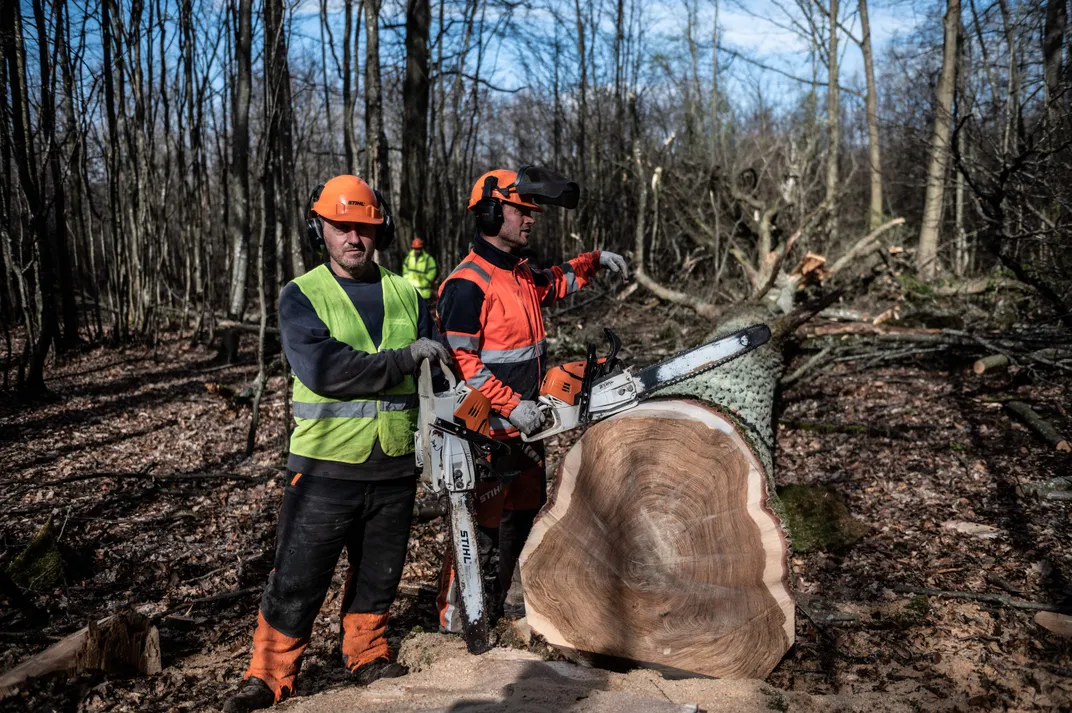Hundreds of Centuries-Old Trees Felled to Rebuild Notre-Dame’s Iconic Spire
French authorities cut down some 1,000 historic oaks as part of the Paris cathedral’s ambitious reconstruction process
:focal(2418x1853:2419x1854)/https://tf-cmsv2-smithsonianmag-media.s3.amazonaws.com/filer/3c/78/3c783c5c-1a82-4707-bc95-c15553bbcda8/gettyimages-1231735821.jpg)
After a devastating fire destroyed much of the roof and iconic Gothic spire of Paris’ Notre-Dame Cathedral in April 2019, architects from around the world proposed an array of ideas for how to rebuild. One envisioned a structure made from recycled ocean plastic, while another suggested that the roof be converted into a cross-shaped swimming pool.
Ultimately, however, the French government agreed to rebuild Notre-Dame’s iconic spire “exactly as it was.” Now, with the time-consuming process of authentic reconstruction well underway, the government is taking a major—and somewhat controversial—step: cutting down 1,000 historic oak trees in more than 200 forests across the country, as Thomas Adamson and Nicolas Garriga report for the Associated Press (AP).
Public and private forests from every corner of France contributed roughly 150- to 200-year-old oaks that were selected through a painstaking process in January and February of this year, per the AP. As Kim Willsher reported for the Guardian in February, the trees needed to be chopped down by the end of March, before their sap rose, to prevent humidity in the wood.
“Given the place occupied by the cathedral in the hearts of the French, in the history of France and the world ... we are happy [that] the entire industry—from foresters to sawyers—is mobilized to meet this challenge,” Michel Druilhe, president of France Bois Forêt, a national professional network for forestry, tells the AP.
Planners scoured France’s forests with drones to spot tall-enough trees with few deformities, reports Saskya Vandoorne for CNN. Eight of the largest trees were taken from the forests of Bercé, in France’s Loire region. These oaks were planted during Louis XIV’s reign (1643–1715), when the famed Sun King was working to expand his navy and needed wood for his ships’ masts. The trees naturally grow with a slight curve, making them ideally suited for their destination as the bulk of the reconstructed wooden spire.
Some of the felled trees stood 60 feet tall, according to the AP. Before it was cut down this week, one tree had lived for more than 230 years: As CNN notes, the oak was just a sapling during the French Revolution.
Naomi Rea of Artnet News reports that a petition condemning the trees’ removal as “ecocide” garnered more than 40,000 signatures. In response, officials pointed out that the oaks would have been cut down anyway during routine forest maintenance.
Per a translation by the Guardian, Dominique de Villebonne, deputy director of France’s National Forests Office (ONF), told Le Parisien’s Emilie Torgemen that the project “is about ancient forestry heritage, not 20-year-old trees, but those that are very old, including plantations ordered by former kings to build ships and ensure the grandeur of the French fleet.”
Architects Philippe Villeneuve and Rémi Fromont are overseeing the reconstruction of the spire, which was designed by Eugène Emmanuel Viollet-le-Duc in 1859 and stood 93 meters (305 feet) tall. They will also painstakingly reconstruct the roof’s wooden lattice. (Per the New York Times, the roof’s attic was previously dubbed the forêt, or forest, for its highly flammable nest of century-old beams.)
Workers have been cleaning up the damage wrought by the blaze and stabilizing the building’s lower levels since 2019, reports the Guardian.
French President Emmanuel Macron has previously stated that the country plans to reopen the Unesco World Heritage site by 2024, in time for the Paris Summer Olympics. But many have dismissed this plan as “unrealistic,” per the AP. Authentic reconstruction takes time: For instance, the trees themselves need to be dried for up to 18 months before they can be used in construction.
As of right now, work on the cathedral reconstruction is not expected to begin until 2022.
/https://tf-cmsv2-smithsonianmag-media.s3.amazonaws.com/accounts/headshot/nora.png)


/https://tf-cmsv2-smithsonianmag-media.s3.amazonaws.com/accounts/headshot/nora.png)